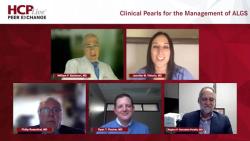Updates in the Management of Alagille Syndrome - Episode 4
Patient Journey to ALGS Diagnosis
Philip Rosenthal, MD, discusses his approach to the diagnostic workup for Alagille syndrome.
William F. Balistreri, MD: Let’s dig a little deeper. Let’s talk about the patient journey. Dr Rosenthal, [let’s say] a patient shows up in your clinic, a newborn with cholestasis….What’s your strategy? What’s your protocol to sort out whether this is Alagille or something else, including biliary atresia?
Philip Rosenthal, MD: The key here is to first make sure the patient doesn’t have biliary atresia. That’s of the utmost importance. As we all know, doing a Kasai procedure [on a patient] by 2 months of age is the most ideal way to have success at reestablishing bile flow. Once biliary atresia has been ruled out, which may include liver biopsy, some [clinicians]—not myself—do nuclear scans to try to see if there’s excretion of isotope into the intestine. Some will get an ultrasound to see if there’s presence or absence of the gallbladder.
Having that work-up completed, the patient may an intraoperative cholangiogram to see if there’s patency both down into the duodenum and up into the radicals of the liver. If that isn’t the case, then the diagnosis of biliary atresia has been made and a Kasai portoenterostomy is appropriate. I’ve seen patients with Alagille syndrome unfortunately wind up with Kasai portoenterostomies, and I’m sure everyone on this panel is aware that patients with Alagille syndrome who get a Kasai portoenterostomy do pretty poorly and usually wind up requiring a liver transplant sooner rather than later. It’s key to confirm biliary atresia as the first step. If there’s any doubt about that, they need to go to the OR [operating room].
Once that’s been done, because it takes a while to get back the genetic testing, I’d send off the Travere [Therapeutics] panel, which you can get for free. You can’t beat the price. But I know that…there are several other panels available. One needs to make sure that they don’t have α-1 antitrypsin deficiencies. That’s usually on those genetic panels. But if you’re uncertain, you could also get α-1 level, and that’ll give you a ballpark idea of whether that’s possibly a metabolic cause of the cholestasis that one sees. Obviously, you’re going to get transaminases, total and direct bilirubin, and a GGT [γ-glutamyl transferase]. Those are routine.
If they’re cholestatic, you’re going to probably want to also take a look at fat-soluble vitamins and get an INR [international normalized ratio] to assess vitamin K. I’d look very carefully on physical exam. Are there characteristic facies? Does the patient have a murmur? Especially if it’s peripheral pulmonic stenosis. Does the patient have hemivertebrae or butterfly vertebrae? Do they have the embryotoxon from ophthalmology? I’ll often send these babies to ophthalmology to get a good look at their optic disc and to see if they have any abnormalities….
William F. Balistreri, MD: As you’re going through that, you mentioned doing genetic testing. You often end up with an unexpected result, such as PFIC [progressive familial intrahepatic cholestasis], the terminology used for that whole spectrum of genetic forms of cholestasis. It’s very similar to Alagille syndrome in many ways. What you outlined is an appropriate strategy. I don’t know if our panelists add anything else to that work-up. Does anybody want to add anything?
Philip Rosenthal, MD: I’ll just mention that nowadays I’ve also been getting serum bile acids as part of my routine work-up, which I didn’t do in the past because it isn’t part of the usual routine panel. But as we’ll discuss later, with the therapies that are available, having a serum bile acid baseline is often very useful.
William F. Balistreri, MD: Good. You’re breaking my heart not doing bile acid routinely, but that’s for another day. Any other approaches, team? Reggie, do you want to add something?
Regino P. Gonzalez-Peralta, MD: No, Phil did a good job of describing. I was just going to ask him, are you checking serum bile acid up front? Or do you wait for GGTs to be normal? Are you saying bile acids up front just because of treatments that we now have available that might lead to reductions, and maybe forecasting improvement or outcomes based on bile acids? I’m pretty sure I’m getting way ahead of myself.
Philip Rosenthal, MD: I’d get bile acids early on. One has to realize that in an infant you’re limited by the amount of blood draw you can do. You can’t get every single test that you’d love to have all at once. You have to prioritize things. But earlier on, I’d get bile acids. You’re right. I look at GGT, because if they have normal GGT, then they may have [progressive familial intrahepatic cholestasis 1 or 2], as Bill mentioned. That’s also very helpful to see if a patient is cholestatic and has a normal GGT. I should add that’s also a possibility for a bile acid synthesis defect. Those are all in the differential. But nowadays, I’m much more inclined early on to get serum bile acid levels than I was in the past.
William F. Balistreri, MD: Thank you, Phil.
TRANSCRIPT EDITED FOR CLARITY



